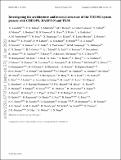Investigating the architecture and internal structure of the TOI-561 system planets with CHEOPS, HARPS-N, and TESS
Author(s)
Vanderburg, Andrew; Seager, Sara
DownloadAccepted version (8.533Mb)
Open Access Policy
Open Access Policy
Creative Commons Attribution-Noncommercial-Share Alike
Terms of use
Metadata
Show full item recordAbstract
<jats:title>ABSTRACT</jats:title>
<jats:p>We present a precise characterization of the TOI-561 planetary system obtained by combining previously published data with TESS and CHEOPS photometry, and a new set of 62 HARPS-N radial velocities (RVs). Our joint analysis confirms the presence of four transiting planets, namely TOI-561 b (P = 0.45 d, R = 1.42 R⊕, M = 2.0 M⊕), c (P = 10.78 d, R = 2.91 R⊕, M = 5.4 M⊕), d (P = 25.7 d, R = 2.82 R⊕, M = 13.2 M⊕), and e (P = 77 d, R = 2.55 R⊕, M = 12.6 R⊕). Moreover, we identify an additional, long-period signal (&gt;450 d) in the RVs, which could be due to either an external planetary companion or to stellar magnetic activity. The precise masses and radii obtained for the four planets allowed us to conduct interior structure and atmospheric escape modelling. TOI-561 b is confirmed to be the lowest density (ρb = 3.8 ± 0.5 g cm−3) ultra-short period (USP) planet known to date, and the low metallicity of the host star makes it consistent with the general bulk density-stellar metallicity trend. According to our interior structure modelling, planet b has basically no gas envelope, and it could host a certain amount of water. In contrast, TOI-561 c, d, and e likely retained an H/He envelope, in addition to a possibly large water layer. The inferred planetary compositions suggest different atmospheric evolutionary paths, with planets b and c having experienced significant gas loss, and planets d and e showing an atmospheric content consistent with the original one. The uniqueness of the USP planet, the presence of the long-period planet TOI-561 e, and the complex architecture make this system an appealing target for follow-up studies.</jats:p>
Date issued
2022-02-26Department
Massachusetts Institute of Technology. Department of Physics; MIT Kavli Institute for Astrophysics and Space Research; Massachusetts Institute of Technology. Department of Earth, Atmospheric, and Planetary Sciences; Massachusetts Institute of Technology. Department of Aeronautics and AstronauticsJournal
Monthly Notices of the Royal Astronomical Society
Publisher
Oxford University Press (OUP)
Citation
Vanderburg, Andrew and Seager, Sara. 2022. "Investigating the architecture and internal structure of the TOI-561 system planets with CHEOPS, HARPS-N, and TESS." Monthly Notices of the Royal Astronomical Society, 511 (3).
Version: Author's final manuscript